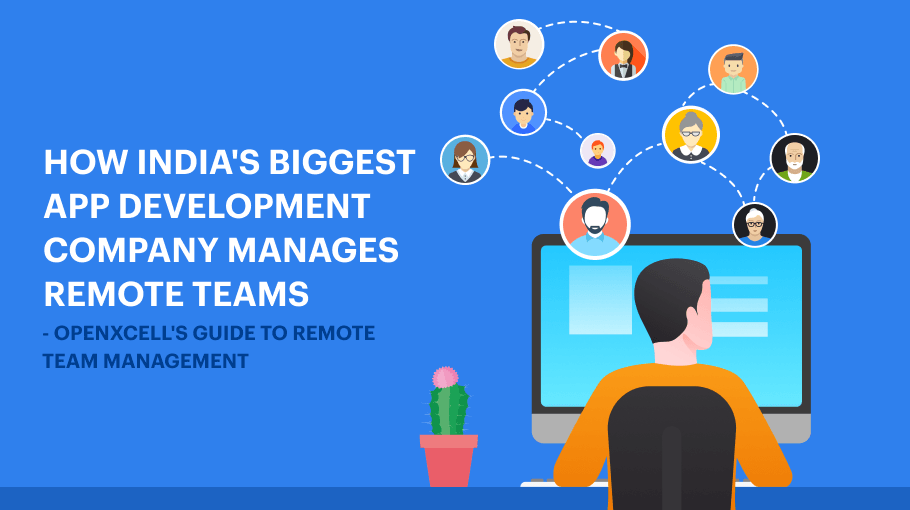- Challenges in Managing Remote Teams
-
Proven Tips for Managing Remote Teams
- Tip 1. Schedule communications
- Tip 2. Tools for Remote Teams
- Tip 3. Define work procedures
- Tip 4. Find a nice work spot
- Tip 5. Go on a business trip
- Tip 6. Get really involved
- Tip 7. Provide constant feedback
- Tip 8. Stay on the same page
- Tip 9. Reward your developers
- Tip 10. Trust your team
- Managing a Remote Team: Closing Thoughts
Today’s entrepreneurs believe in smart work. This urges startups to use an effective & strategic business approach. Managing remote teams is the citation faced that’s why young entrepreneurs are shifting their focus toward offshore development.
By outsourcing IT services in countries like India, companies in the USA and Europe are enjoying the cost and other several benefits.
We have covered the benefits of outsourcing several times in the past, therefore, let’s move ahead & discuss how to manage a remote team effectively.
Challenges in Managing Remote Teams
A remote team is a group of experts from different time zones, with distinct skills, and different cultures working unitedly on a unified project.
Currently, all small, moderate, big enterprises are focusing on adopting remote working as this is beneficial for current and upcoming time.
- As per the survey, it has been found that 82% of respondents said that they experience less stress.
- As per the Harvard Business Review, 87% of respondents feel more connected via remote working.
When the team works from the office, then it requires less management effort as a comparison to remote working. While managing the remote team, many challenges come across, and some of the challenges of managing remote employees are related to:
- Lacking the Top Communication Tool
- Hiring the Correct Resources
- Lacking Accountability Program
- Noticing Everyone’s Time
- Unclear Roles and Tasks
- Lack of Schedule
- Unmanageable Employee Tracking
- Lack of Conversation within the Team
What is the Biggest Advantage of Remote Working?
Statista stated that in 2020, 32% of respondents said that flexibility is one of the most significant benefits of remote working.
When the employee of the company will be productive, then only you will be able to boost the business growth, but for that, it is indispensable to manage the remote working properly.

You should do a proper module to manage the remote team and work. Here are a few ways that will help you to manage the remote team.
- Make Use Of Modern Technologies
- Proper Checkment On Punch In and Punch-Out
- Don’t Let Communication Gap Hamper your Productivity
- Make Sure that Your Team Is Satisfied
- Focus On Final Result Not on Activity
- Arrange Proper Resources
- Offer Flexibility
Proven Tips for Managing Remote Teams
Tip 1. Schedule communications
Your remote team will be working from a different location and probably a different time zone.
Strictly keeping scheduled meetings will help you organize your day and your team’s workflow. Not having timely meetings can cause gaps in communication, delaying the launch of your project.
Read This: Top Enterprise Mobility Trends to Look Out for in 2020
Tip 2. Tools for Remote Teams
Tools are essential for remote team collaboration as they help you structure your team’s work.
An effective remote team will have a set of tools such as an email service, file sharing capabilities, an instant messaging platform, project management software, video conferencing, and anything else that’s required. Many collaboration tools exist to support well-structured communication.
Tip 3. Define work procedures
Create clear project guidelines for productivity, teamwork, and accountability so your employees know what to expect. Present the idea of your project and describe what you want to be done in detail.
The estimate for your project will depend on what you communicate to your team. Your team can start developing your product faster as top mobile app development companies are doing and giving more precise quotes if you provide your vision for the project clearly.
You need to pre-planned tasks and give detailed answers. Review the project requirements document attentively to make sure you have included all functionality. Respond promptly to emails from your project manager since they are the ones to pass down what you say to the team. The development of your product will depend on the information your team gets.
Most IT companies work according to Agile methodologies. It’s wise to break development down into iterations. Discuss how often you’re going to conduct project meetings and what communication tools you’ll use.
Agree with your project manager to have a quick summary session after each meeting to form new goals and analyze the decisions you’ve made.
Read This: Mobile App Development Cost Report 2020
Tip 4. Find a nice work spot
Find a nice quiet place where you can conduct regular meetings. The best place is an office room equipped with a good internet connection and a modern computer with a microphone and video camera.
If you lack one of these things, your communication won’t be successful and productive. If you choose a noisy place, you may get distracted and lose focus.
Tip 5. Go on a business trip
Go on a short business trip to meet the IT professionals you’ve hired in person. This is a good start for your project. While on-site, you can have a few sessions where you settle all questions regarding your projects.
Neither or nor your team members will be pressed for time in this case, and everyone will be dedicated to communicating together in the same meeting room. Alongside the shop talk, you can establish personal connections.
Your employees can also get inspired by your excitement and vision for the project, which will stick with them and keep them going through the launch.
Tip 6. Get really involved
The success of your product depends on your involvement. If a client doesn’t care, leaves their employees without notice, and comes back when it’s time to launch, the result may be disappointing. Your team will expect you to show genuine interest all the way through the launch.
After all, you’re the project initiator and your team’s cheerleader. For a start, be the first to show up online for meetings, showing that you’re dedicated to your business.
Tip 7. Provide constant feedback
The results of every iteration and sprint depend on how quickly and eхtensively you provide feedback. Discuss with your project manager what tool you’ll use so that you can inform everyone of the decisions you’ve made and tasks that need to be done.
Read This: Personalized Advertisements in Mobile is Dying. Here’s Why
Tip 8. Stay on the same page
To keep communication clear, make yourself easy to understand. Decide on the terminology that you’re going to use so that everyone means the same thing when talking about the project.
Try to express your thoughts without using slang or idioms that may be misinterpreted. A sense of humor is a good tool to foster positive communication. Make sure you smile and throw a joke now and then when you have a video call to keep everyone at ease.
Tip 9. Reward your developers
You are your team’s leader and your employees will look to you for approval. Giving tasks is one thing, but giving praise for work done is another in team management. Praise is sure to boost your team’s performance.
To start on a high note, you can kick off each meeting with praise for the job done so far. Make sure you explain what you like about the course of the project. If you can give constructive praise, your team will understand that they are moving in the right direction.
During or at the end of development, you can show your appreciation by sending your team gifts like T-shirts or badges with your company logo or your product. You can also reward them with cash bonuses.
By giving bonuses, you’re investing in your project. Of course, this generosity may not be necessary, but it’s sure to leave a lasting impression of your cooperation.
Tip 10. Trust your team

Managing programmers means trusting them. When you hire an offshore company, don’t treat their employees as your property but rather as individuals who can make your idea a reality. Treat them as your team members and encourage them. Your project is already as important to them as it is to you.
If you don’t study what’s been done and provide good feedback, you risk spending more hours doing things over because you didn’t give due attention earlier.
Listen to your developers and designers to get a better understanding of the functionality, especially if you don’t have a technical background.
It’s clear that tastes differ, especially when multiple cultures are involved. But if you entrust your product to your offshore team members, you need to trust them. There’s a lot of experience and knowledge behind the suggestions they’ll likely make to improve your product.
Take their suggestions into account and consider the outcome of implementing those suggestions. Simply put, trust the ideas that your developers and designers express as far as development and design are concerned.
Read This: How Can Mobile Applications Help us Fight the Next Pandemic
Hire a full-stack software company. A full-stack development company will start from idea inception and finish with supporting your product after release.
If you hire third-party designers or QA engineers, you’ll have to spend more time coordinating the workflow of two independent teams.
Managing a Remote Team: Closing Thoughts
Working with a remote team online is not much different than working with a team in person. Follow the work procedures you’ve set with your project manager and show enthusiasm as well as responsibility for the progress of development.
Inspire your team by being genuinely involved and forming goals clearly to make everything go as planned. Provide feedback on even the smallest details regarding your product. The overall success of your project and the speed of development will depend on the responses you provide to your team.
If you’re looking for a remote team, get in touch with Openxell! We love what we do and are easy to work with since we’re familiar with the best practices of managing remote teams and know how to manage a remote team.








